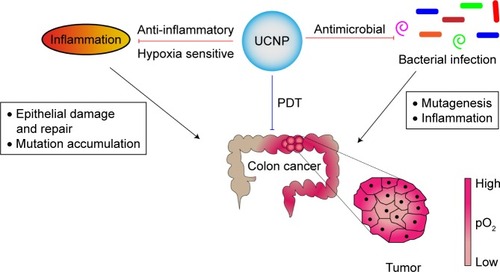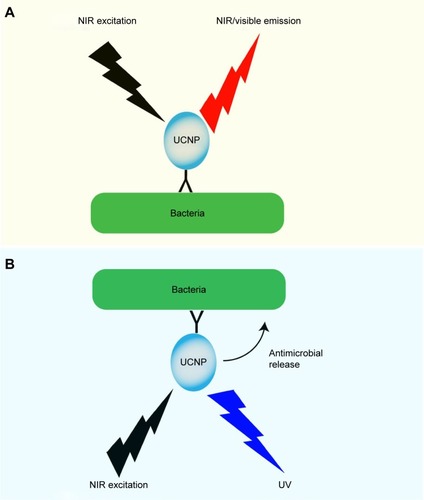Figures & data
Figure 1 In vivo applications of UCNPs in intestinal infection, inflammation, and colorectal cancer.
Notes: In this figure, we depict potential (red arrows) and current (blue arrow) target areas where UCNPs can be used either for imaging or treating infection, inflammation, and colon cancer. Bacterial infection and/or inflammation leading to IBD and colorectal cancer are depicted with black arrows. UCNPs loaded with antimicrobial and anti-inflammatory compounds can be used to treat infection, inflammation, and cancer. Furthermore, hypoxia-sensitive UCNPs can be used to monitor the hypoxic state of the gastrointestinal tract. Due to the NIR excitation range, UCNPs are currently being used for localized PDT in certain cancer forms.
Abbreviations: IBD, inflammatory bowel disease; NIR, near infrared; PDT, photodynamic therapy; UCNPs, upconverting nanoparticles.

Figure 2 UCNP characteristics.
Notes: (A) A cross-sectional schematic representation of a typical UCNP. This includes an optically inert host crystal where optically active Ln3+ activator and sensitizer ions are embedded by replacing the cations of host matrix in the crystallization process. (B) Lanthanide-based UCNPs in colloidal solution are able to convert NIR light into different wavelengths in the VIS region of the EM. Reproduced from Zhong Y, Tian G, Gu Z, et al. Elimination of Photon Quenching by a Transition Layer to Fabricate a Quenching-Shield Sandwich Structure for 800 nm Excited Upconversion Luminescence of Nd3+-Sensitized Nanoparticles. Adv Mater. 2013;26(18):2831–2837.Citation29 Publisher: John Wiley and Sons. © 2013 WILEY-VCH Verlag GmbH & Co. KGaA, Weinheim. (C) Ln3+ ions exhibit different emission spectral bands under NIR excitation, spanning from NIR to VIS and UV regions as each Ln3+ has its unique energy level structure.
Abbreviations: EM, electromagnetic; NIR, near infrared; UCNP, upconverting nanoparticle; UV, ultraviolet; VIS, visible.

Table 1 List of published studies where UCNPs were used to detect bacteria
Figure 3 Mode of action of UCNPs in visualizing and killing bacteria.
Notes: In this figure, we summarize published work on UCNPs’ role in visualizing and killing bacteria. (A) Functionalized UCNPs targeting bacteria with NIR/VIS emission range is used to image the bacteria. (B) UCNPs loaded with antimicrobial compounds or with an UV emission range are used for localized antimicrobial activity.
Abbreviations: NIR, near infrared; UCNPs, upconverting nanoparticles; UV, ultraviolet; VIS, visible.

Table 2 Antimicrobial actions of UCNPs
Table 3 Colorectal cancer detection and treatment using UCNPs
